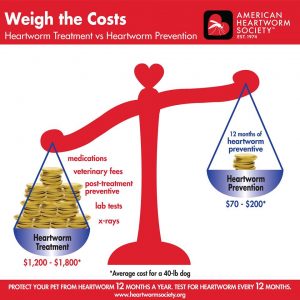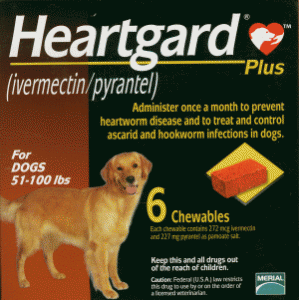When clients bring in their pets for vaccines they often ask why it is necessary to do an exam. Each pet should have a physical exam at least once per year. Senior pets or patients with chronic health conditions may need more frequent exams. A lot can change in a year, especially since pets age much faster than humans.
Detectives
Animals instinctively hide signs of disease; this is a natural survival mechanism. Your pet’s physical exam and the history taken can give trained veterinary professionals clues to possible hidden conditions. It is important to pay attention to your pet’s regular activities, note when they divert from normal, and report the abnormalities to your veterinary team.
Prevention
The old saying “an ounce of prevention is worth a pound of cure” rings true. For example, according to the American Heartworm Society, 12 months of heartworm prevention costs approximately $70-200, while heartworm treatment can cost $1,200 to $1,800. (Our estimate for preventives runs about $60-150.)

Catch It Early
Diagnosing a disease in its early stages can hopefully decrease the effects on the patient and prolong the quality of life, as well as increase success and decrease the cost of treatment. For example, damage to the kidneys cannot be reversed; the treatment goal is to prevent or slow the kidney function from deteriorating.
Prescriptions
Veterinarians are required by law to examine a patient in order to dispense any prescription medication. This establishes the mandatory patient-doctor-client relationship. For ongoing prescriptions, the patient must be seen once yearly in order to continue refilling the medications. Certain medications have adverse effects if used long-term. For example, Rimadyl use can lead to liver damage. Your veterinarian may recommend checking bloodwork regularly to monitor the effects on the patient.
Note: Heartworm preventives and oral flea & tick products are prescription medications and require the patient-doctor-client relationship to be established.



Questions & Answers
Your pet’s annual exam is a perfect time to ask all the questions you may have about your their health, behavior, and overall care. Our veterinary team is here to help educate you and assist you in providing the best quality of life for your pets.
What happens during a physical exam?
Veterinary professionals are trained to be observers and multi-taskers. You may not even notice everything that is being evaluated during the physical exam. The technician and veterinarian may be asking you questions and talking with you through the entire exam. Here are some examples:
- Temperature- If your pet is running a fever, it may mean they are already fighting off a “bug”. Giving them vaccines at this time could overload the immune system, lessening the chance the body can fight the “bug” off on its own. This can also decrease the effectiveness of the vaccines.
- Weight & Nutrition – Statistics show that over half of all cats & dogs in the United States are overweight. Keeping your pet at a healthy weight can minimize the risk of diseases and conditions such as arthritis and diabetes. Feeding a well-balanced diet can improve your pet’s overall health. The weight and Body Condition Scores are evaluated during an exam. The veterinarian can make recommendations for diet changes or add supplements based on your pet’s individual health needs.
- Eyes- It is normal for changes to occur to the eyes of aging patients. These changes can cause vision loss and may ultimately lead to blindness. Detecting and treating them early can postpone vision loss and lead to a better quality of life for your pet.
- Ears- Ear infections are a common ailment for dogs that often go unnoticed. Ear infections can be anywhere from a minor annoyance to a very painful condition. Think of how a child reacts to an ear infection; they are often miserable and inconsolable. Imagine your dog feeling that
- Heart & Lungs- A quick listen to the chest of a patient can identify or give suspicion of multiple things. A stethoscope is used to detect abnormalities in the heart, lungs, and airways. At this time the heart rate and respiration rate are also measured.
- Abdomen- Each organ has its designated spot and takes up a certain amount of space in the abdomen. Any abnormalities in size, positioning, or the patient’s reaction to palpation of the area can give the suspicion of a problem. Diagnostics may be recommended to further determine the condition.
- Mouth- Dental disease is one of the most common conditions in veterinary medicine. How often do you look in your pet’s mouth? Pets don’t practice good oral hygiene like brushing their teeth, flossing, and getting regular dental checkups on their own.
- Lymph Nodes- Your pet has lymph nodes situated in specific locations throughout the body. A swollen lymph node can be an indication of disease in that specific area of the body.
- Lumps-As pets age they often develop different lumps and bumps. The veterinary team can palpate the lumps and let you know which ones are concerning, need to be removed, or can just be monitored.
Call Bemidji Veterinary Hospital today at (218) 751-2753 to schedule your pet’s annual physical exam.
What's Next
Call us or schedule an appointment online.
Meet with a doctor for an initial exam.
Put a plan together for your pet.


